Analysis of Influencing Factors on the Tribological Behavior of 42CrMo4/17NiCrMo6-4 under Grease Lubrication
Abstract
:1. Introduction
2. Specimen Preparation and Experimental Methods
2.1. Specimen Preparation
2.2. Characterization and Analysis
2.3. Experimental Methods
3. Results and Discussion
3.1. Significance Analysis
3.1.1. Friction Coefficient
3.1.2. Wear Volume of 17NiCrMo6-4
3.1.3. Wear Volume of 42CrMo4
3.2. Univariate Analysis
3.2.1. Load
- 1.
- The influence of load on the friction coefficient
- 2.
- The influence of load on wear volume
- 3.
- The influence of load on the surface microstructure
- When the load is below 800 , the predominant wear type on 42CrMo4 is abrasive wear [31], accompanied by a small amount of plastic deformation. This can be attributable to the slight plastic deformation of the contact asperities on the surface when the load is relatively low, while fewer asperities actively participate in the frictional process. As a result, the abrasive particles generate fewer grooves along the sliding direction on the material surface. However, as the load increases, the plastic deformation of the asperities intensifies, involving a greater number of asperities in the frictional process, leading to deeper grooves and increased surface wear. Furthermore, the increase in load generates higher frictional heat, causing the matrix to soften, which promotes adhesive wear and contributes to an overall increase in wear volume, as shown in Figure 14.
- At an 800 N load, 17NiCrMo6-4 experiences severe spalling. This is attributable to the higher cyclic stress exerted on the surface of the specimen. With the same number of cycles, the likelihood of cracks forming becomes higher, and under greater pressure conditions, spalling occurs from the crack sites due to the tearing effect of adhesive wear [32], as shown in Figure 15.
- Based on the three-dimensional topography (Figure 11c) and microtopography images (Figure 13e,f) under a 1200 N load, it can be observed that the predominant wear types on 42CrMo4 are abrasive wear and adhesive delamination [31], while 17NiCrMo6-4 exhibits primarily plastic flow and adhesive delamination. Even after ultrasonic cleaning, a layered structure is still visible. This is attributable to the excessively high load, which generates a significant amount of wear debris in the early stage of wear. Some of the debris escapes the frictional system, while the remaining debris undergoes repeated compaction on the material surface under high loads. The high shear stress induces severe plastic deformation between the specimens, resulting in welding phenomena. The surface hardness is further increased due to the work-hardening effect. The presence of an adhesive layer on the specimen surface hinders the initiation of new wear, providing better protection for the underlying substrate. As a result, the wear volume decreases with increasing load.
3.2.2. Hardness Matching
- 1.
- The Influence of hardness matching on friction coefficient
- 2.
- The Influence of hardness matching on wear volume
- 3.
- The influence of hardness matching on the surface microstructure
4. Conclusions
- (1)
- Hardness matching has the most significant impact on the wear resistance and friction reduction of the friction pair, followed by loads. Increasing the hardness of 42CrMo4 can reduce the friction coefficient and wear volume of the friction pair. The highest surface hardness, compared with the lowest surface hardness of the 42CrMo4 material, resulted in reductions of 21.5% and 87.2% in the friction coefficient and wear volume, respectively. At low hardness, the main failure mode is abrasive wear. At high hardness, the predominant wear type is still abrasive wear, but 17NiCrMo6-4 experiences more severe fatigue wear.
- (2)
- The friction coefficient initially decreases and then stabilizes with increasing load, while the wear volume initially increases and then decreases with increasing load. The wear type transitions from abrasive wear at low loads to a synergistic effect of abrasive and adhesive wear at high loads. With an increase in contact stress, the adhesive layer formation effectively prevents further wear, resulting in a decrease in wear volume.
- (3)
- Under all lubrication conditions, lubricating grease provides sufficient lubrication for the friction pair. The specific changes in friction coefficient and wear volume may be influenced by the interaction of other factors. The criterion for selecting lubricant quantity is to ensure the presence of uniform lubricating grease in the friction system. Excessive lubricant does not improve the wear performance of the friction pair.
Author Contributions
Funding
Institutional Review Board Statement
Informed Consent Statement
Data Availability Statement
Conflicts of Interest
References
- Yang, Y.; Peng, Z.; Zhang, W.; Guang, M. Parameterised time-frequency analysis methods and their engineering applications: A review of recent advances. Mech. Syst. Signal Process. 2019, 119, 182–221. [Google Scholar] [CrossRef]
- Sun, C.; Wang, P.; Yan, R.; Gao, R.; Chen, X. Machine health monitoring based on locally linear embedding with kernel sparse representation for neighborhood optimization. Mech. Syst. Signal Process. 2019, 114, 25–34. [Google Scholar] [CrossRef]
- Pérez, J.M.P.; Márquez, F.P.G.; Tobias, A.; Papaelias, M. Wind Turbine Reliability Analysis. Renew. Sustain. Energy Rev. 2013, 23, 463–472. [Google Scholar] [CrossRef]
- Lawrence, R.M. Wind Energy-the Facts: A Guide to the Technology, Economics and Future of Wind Power, 1st ed.; European Wind Energy Association: London, UK, 2009. [Google Scholar]
- Menezes, E.J.N.; Araújo, A.M.; Silva, N.S.B.D. A review on wind turbine control and its associated methods. J. Clean. Prod. 2018, 174, 945–953. [Google Scholar] [CrossRef]
- Liu, W. A review on wind turbine noise mechanism and de-noising techniques. Renew. Energy 2017, 108, 311–320. [Google Scholar] [CrossRef]
- Gao, H.M.; Wen, C.; Sun, Y.S. Effects of microstructure and temperature on mechanical properties of 42CrMo4 steel. Trans. Mater. Heat. Treat. 2018, 3, 87–92. [Google Scholar]
- Dou, Q.J.; Zhao, Z.H.; Nie, B.H.; Ma, J.; Zhang, Z. Effect of tempering temperature on very high cycle fatigue behavior of 42CroMo steel. Trans. Mater. Heat Treat. 2014, 35, 175–180. [Google Scholar]
- Briscoe, B. Wear of polymers: An essay on fundamental aspects. Tribol. Int. 1981, 14, 231–243. [Google Scholar] [CrossRef]
- Chen, Y.K.; Modi, O.P.; Mhay, A.S.; Chrysanthou, A.; O’Sullivan, J.M. The effect of different metallic counterface materials and different surface treatments on the wear and friction of polyamide 66 and its composite in rolling–sliding contact. Wear 2003, 255, 714–721. [Google Scholar] [CrossRef]
- Wieleba, W. The statistical correlation of the coefficient of friction and wear rate of PTFE composites with steel counterface roughness and hardness. Wear 2002, 252, 719–729. [Google Scholar] [CrossRef]
- Johnney Mertens, A.; Senthilvelan, S. Effect of mating metal gear surface texture on the polymer gear surface temperature. In Proceedings of the 4th International Conference on Materials Processing and Characterization, Hyderabad, India, 14–15 March 2015; pp. 1763–1769. [Google Scholar]
- Pogačnik, A.; Kupec, A.; Kalin, M. Tribological properties of polyamide (PA6) inself-mated contacts and against steel as a stationary and moving body. Wear 2017, 378, 17–26. [Google Scholar] [CrossRef]
- Zhang, P.; Lu, W.L.; Liu, X.J.; Zhai, W.Z.; Zhou, M.Z.; Zeng, W.H. Torsional fretting and torsional sliding wear behaviors of CuNiAl against 42CrMo4 under dry condition. Tribol. Int. 2018, 118, 11–19. [Google Scholar] [CrossRef]
- Zhang, P.; Liu, X.J.; Lu, W.L.; Zhai, W.Z.; Zhou, M.Z.; Wang, J. Fretting wear behavior of CuNiAl against 42CrMo4 under different lubrication conditions. Tribol. Int. 2018, 117, 59–67. [Google Scholar] [CrossRef]
- Tarasiuk, W.; Gordienko, A.I.; Wolocko, A.T.; Piwnik, J.; Szczucka-Lasota, B. The Tribological Properties of Laser Hardened Steel 42CrMo4. Arch. Metall. Mater. 2015, 4, 2939–2944. [Google Scholar] [CrossRef]
- Zhang, Y.T.; Jiang, M.; Wang, G.; Ji, X.L. Experimental Study on the Laser Cladding of T15 Coating for 42CrMo Steel. In Proceedings of the TMS 2020 149th Annual Meeting & Exhibition Supplemental Proceedings, Berlin, Germany, 12 February 2020. [Google Scholar]
- Autay, R.; Kchaou, M.; Dammak, F. Friction and Wear Behaviour of Induction Hardened ISO 42CrMo4 Low-Alloy Steel under Reciprocating Sliding Conditions. Proc. Inst. Mech. Eng. Part J J. Eng. Tribol. 2015, 229, 115–125. [Google Scholar] [CrossRef]
- Wang, J.Y.; Jiang, J.; Wan, S.H.; Fan, W.; Yi, G.W.; Jing, W.D.; Kou, J.S.; Jin, W.J. Simultaneous Formation of the Fes/Fen Compound Layer over 42CrMo Steel for Resisting Wear and Corrosion. Mater. Lett. 2022, 318, 132–141. [Google Scholar] [CrossRef]
- Thakare, A.S.; Butee, S.P.; Kamble, K.R. Improvement in Mechanical Properties of 42CrMo4 Steel Through Novel Thermomechanical Processing Treatment. Metallogr. Microstruct. Anal 2020, 9, 759–773. [Google Scholar] [CrossRef]
- Xu, L.M.; Shi, X.L.; Xue, Y.W.; Zhang, K.P.; Huang, Q.P.; Wu, C.H.; Ma, J.; Shu, J.P. Improving Tribological Performance of 42CrMo under Dry Sliding Conditions by Combining Rhombic-Textured Surfaces with Sn-Ag-Cu Solid Lubricant and MXene-Ti3C2TX. J. Mater. Eng. Perform. 2022, 32, 1275–1291. [Google Scholar] [CrossRef]
- Zhang, K.P.; Shi, X.L.; Xue, Y.W.; Huang, Q.P.; Wu, C.H. Effects of Composite Textured Surface on Friction Characteristics of 42CrMo Steel under Grease Lubrication. Wear 2022, 504, 204–215. [Google Scholar] [CrossRef]
- Pogačnik, A.; Kalin, M. Parameters Influencing the Running-in and Long-Term Tribological Behaviour of Polyamide (PA) against Polyacetal (POM) and Steel. Wear 2012, 290, 140–148. [Google Scholar] [CrossRef]
- Xu, N.; Wang, X.B.; Rui, M.; Li, W.M.; Zhang, M. Insights into the rheological behaviors and tribological performances of lubricating grease: Entangled structure of a fiber thickener and functional groups of a base oil. New J. Chem. 2018, 42, 1484–1491. [Google Scholar] [CrossRef]
- Prölß, M.; Schwarze, H.; Hagemann, T.; Zemella, P.; Winking, P. Theoretical and Experimental Investigations on Transient Run-Up Procedures of Journal Bearings Including Mixed Friction Conditions. Lubricants 2018, 6, 105. [Google Scholar] [CrossRef]
- Westerberg, L.G.; Lundström, T.S.; Höglund, E.; Lugt, P. Investigation of Grease Flow in a Rectangular Channel Including Wall Slip Effects Using Microparticle Image Velocimetry. Tribol. Trans. 2010, 53, 600–609. [Google Scholar] [CrossRef]
- Miettinen, J.; Andersson, P.; Wikströ, V. Analysis of grease lubrication of a ball bearing using acoustic emission measurement. Proc. Inst. Mech. Eng. Part J J. Eng. Tribol. 2001, 215, 535–544. [Google Scholar] [CrossRef]
- Cao, S.F.; Sarasin, F.; Cantoni, M.; Mischler, S. Effect of surface films on tribologically induced metallurgical transformations of steel in oil lubricated contacts. Wear 2016, 368, 75–83. [Google Scholar] [CrossRef]
- Yang, Y.; Zhang, C.; Dai, Y.; Luo, J.B. Tribological properties of titanium alloys under lubrication of SEE oil and aqueous solutions. Tribol. Int. 2017, 109, 40–47. [Google Scholar] [CrossRef]
- Liu, C.P.; Zhao, X.J.; Liu, P.T.; Pan, J.Z.; Ren, R.M. Influence of Contact Stress on Surface Microstructure and Wear Property of D2/U71Mn Wheel-Rail Material. Materials 2019, 12, 3268. [Google Scholar] [CrossRef] [PubMed]
- Almeida, J.; Horovistiz, A.; Davim, J.P. Digital representation of the wear behaviour of Ti-6Al-4V and Ti-6Al-7Nb biomaterial alloys: A fractal analysis of the worn surface. Proc. Inst. Mech.Eng. Part J J. Eng. Tribol. 2023, 237, 1156–1169. [Google Scholar] [CrossRef]
- Bandeira, A.L.; Trentin, R.; Aguzzoli, C. Sliding wear and friction behavior of CrN-coating in ethanol and oil–ethanol mixture. Wear 2013, 301, 786–794. [Google Scholar] [CrossRef]
- Sedriks, A.J.; Mulhearn, T.O. The effect of work-hardening on the mechanics of cutting in simulated abrasive processes. Wear 1964, 7, 451–459. [Google Scholar] [CrossRef]
- Sedriks, A.J.; Mulhearn, T.O. Mechanics of cutting and rubbing in simulated abrasive processes. Wear 1963, 6, 457–466. [Google Scholar] [CrossRef]
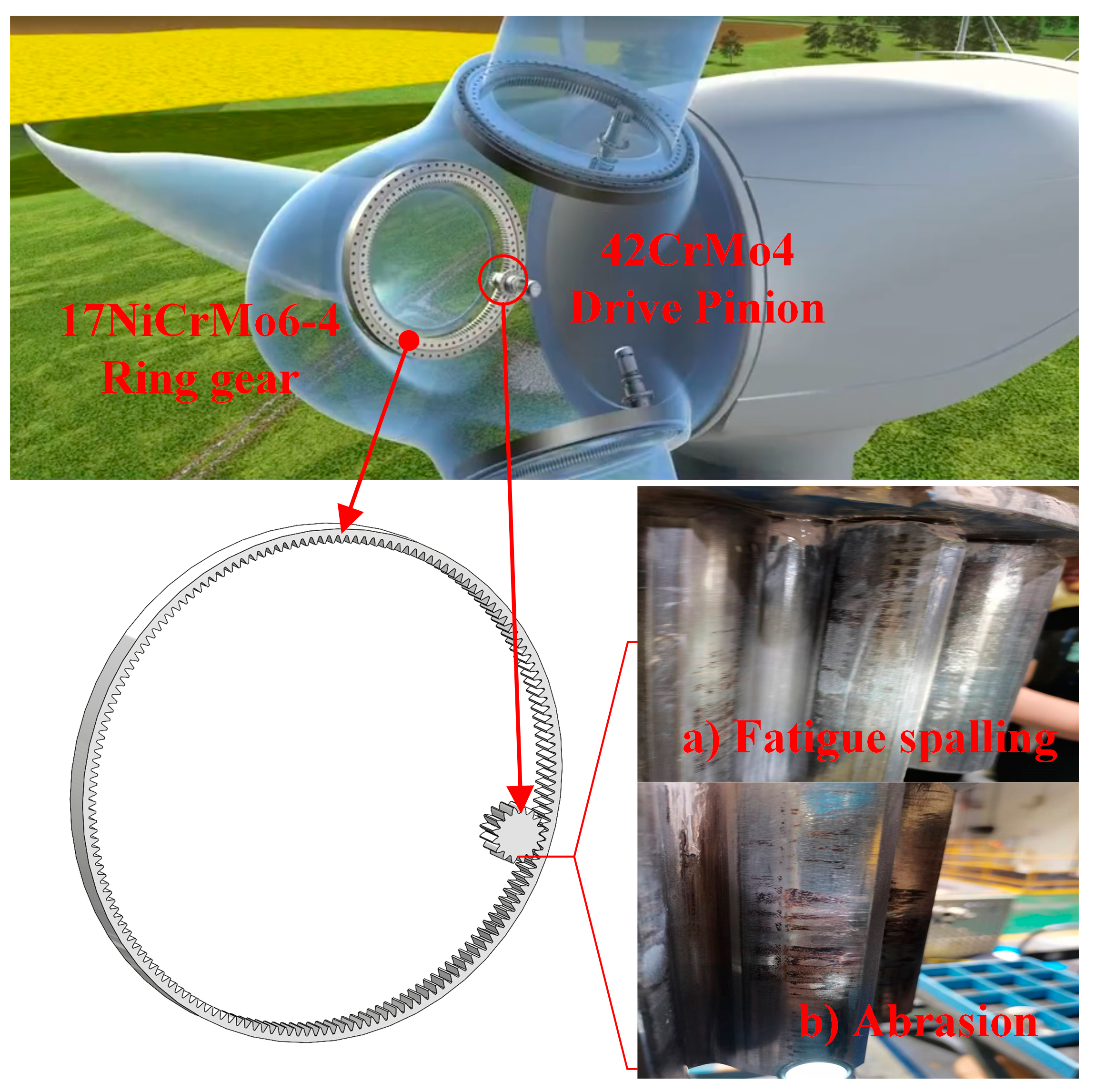

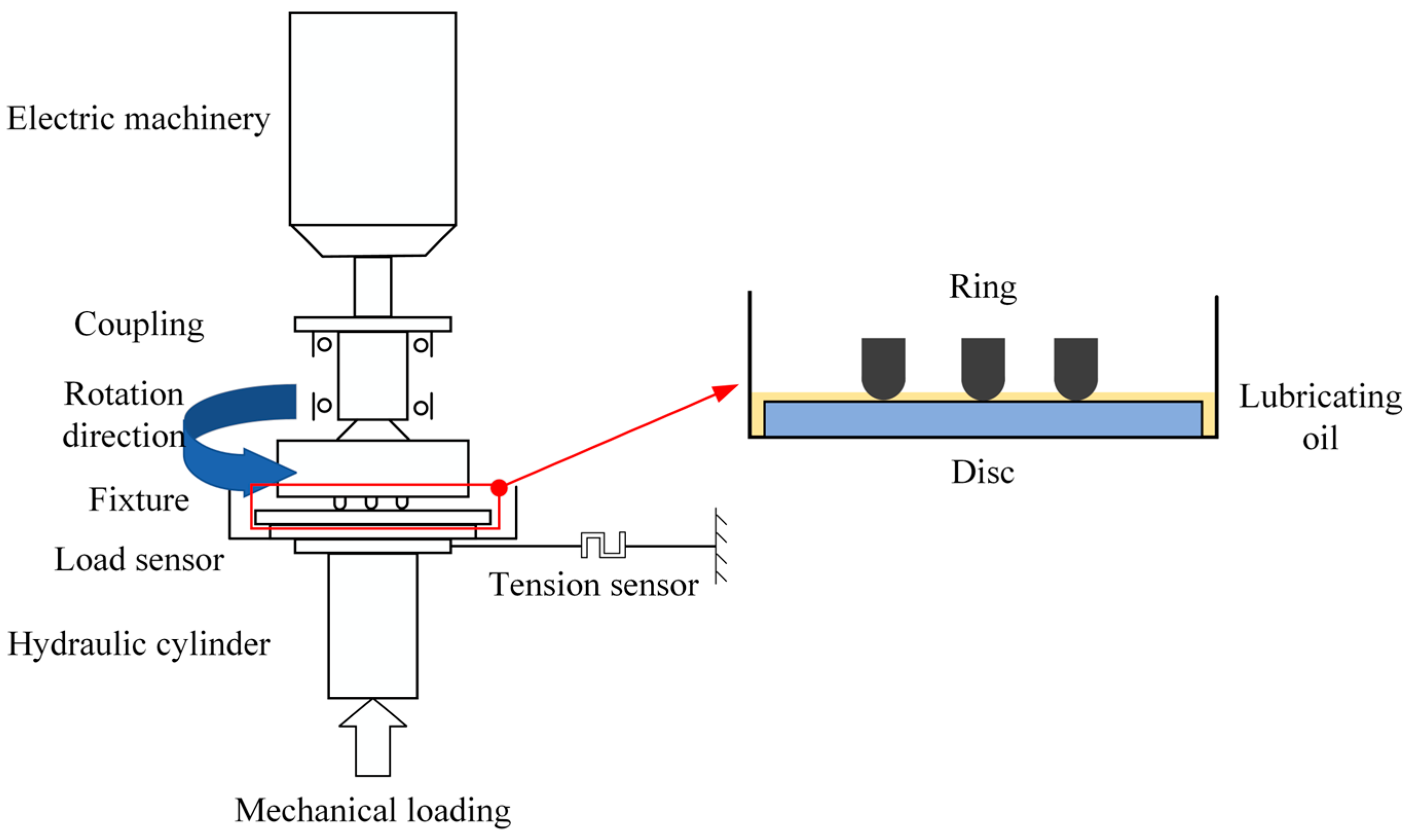
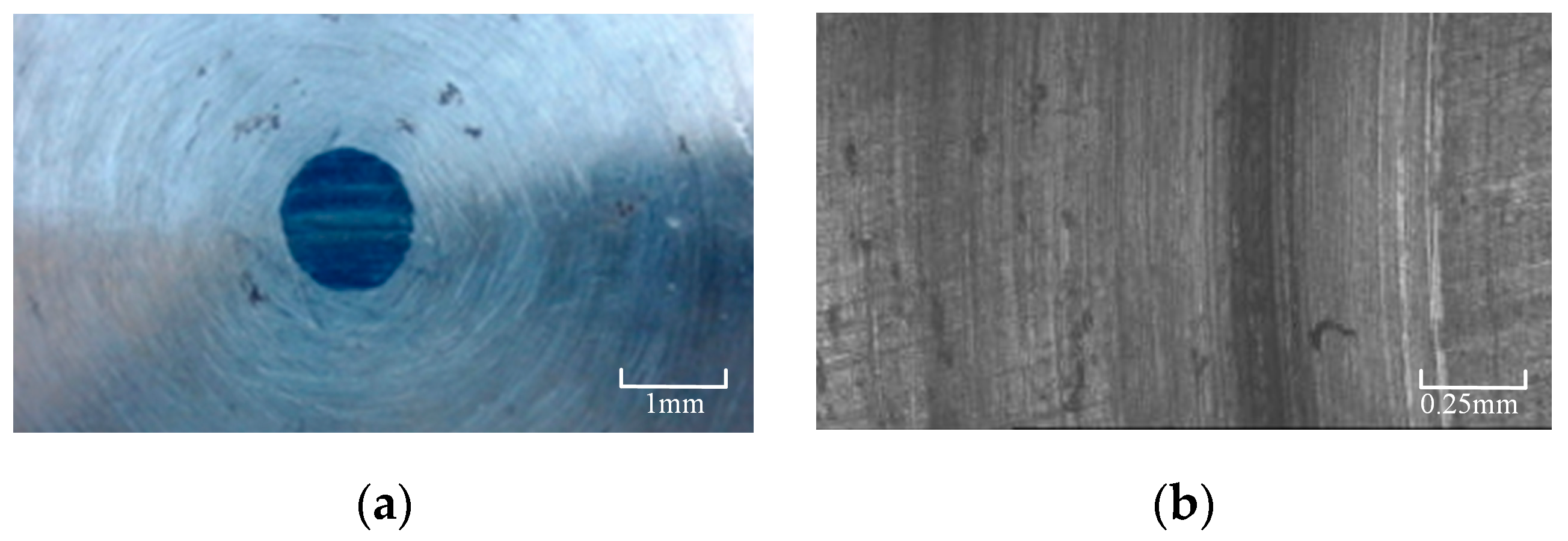

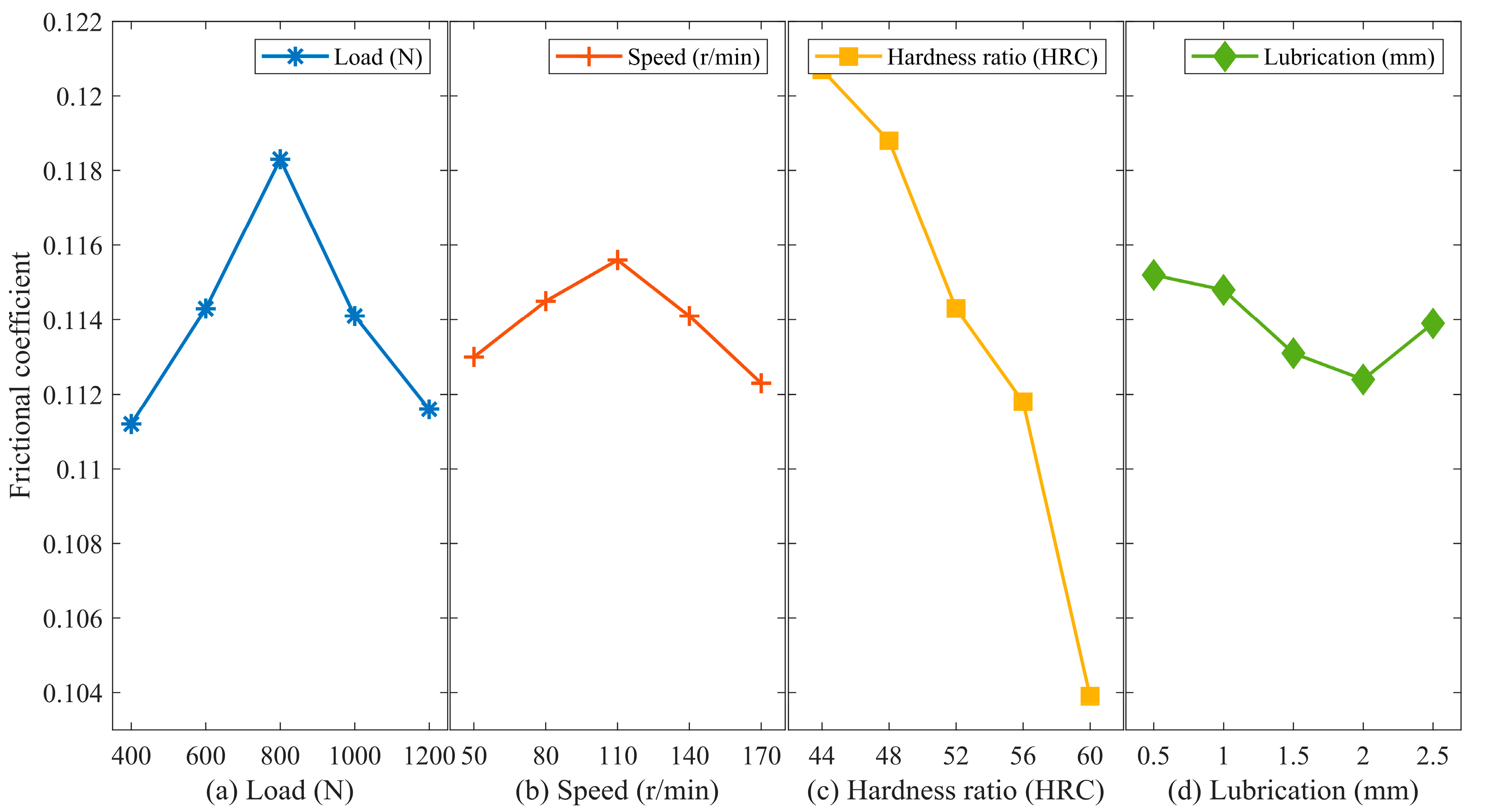
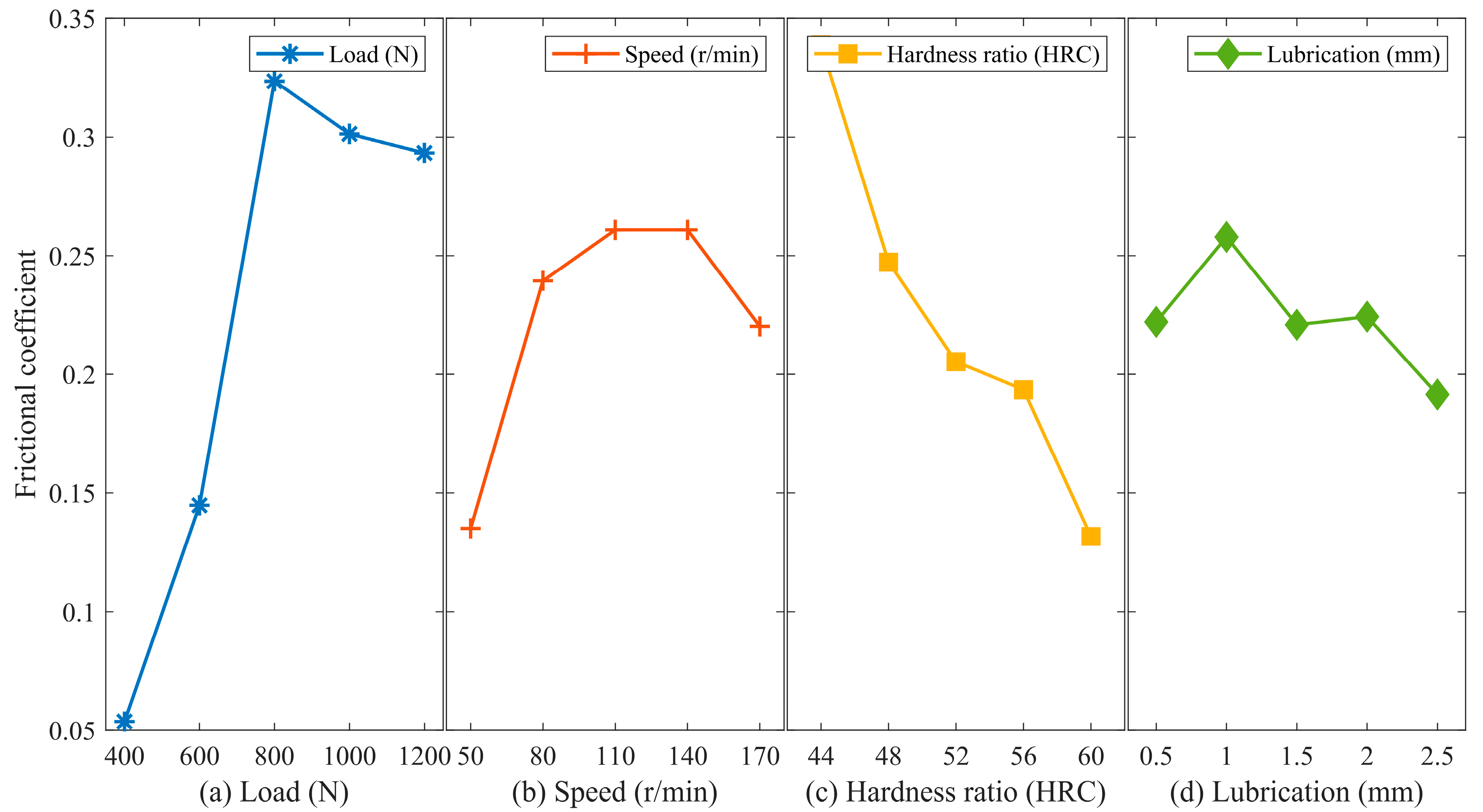
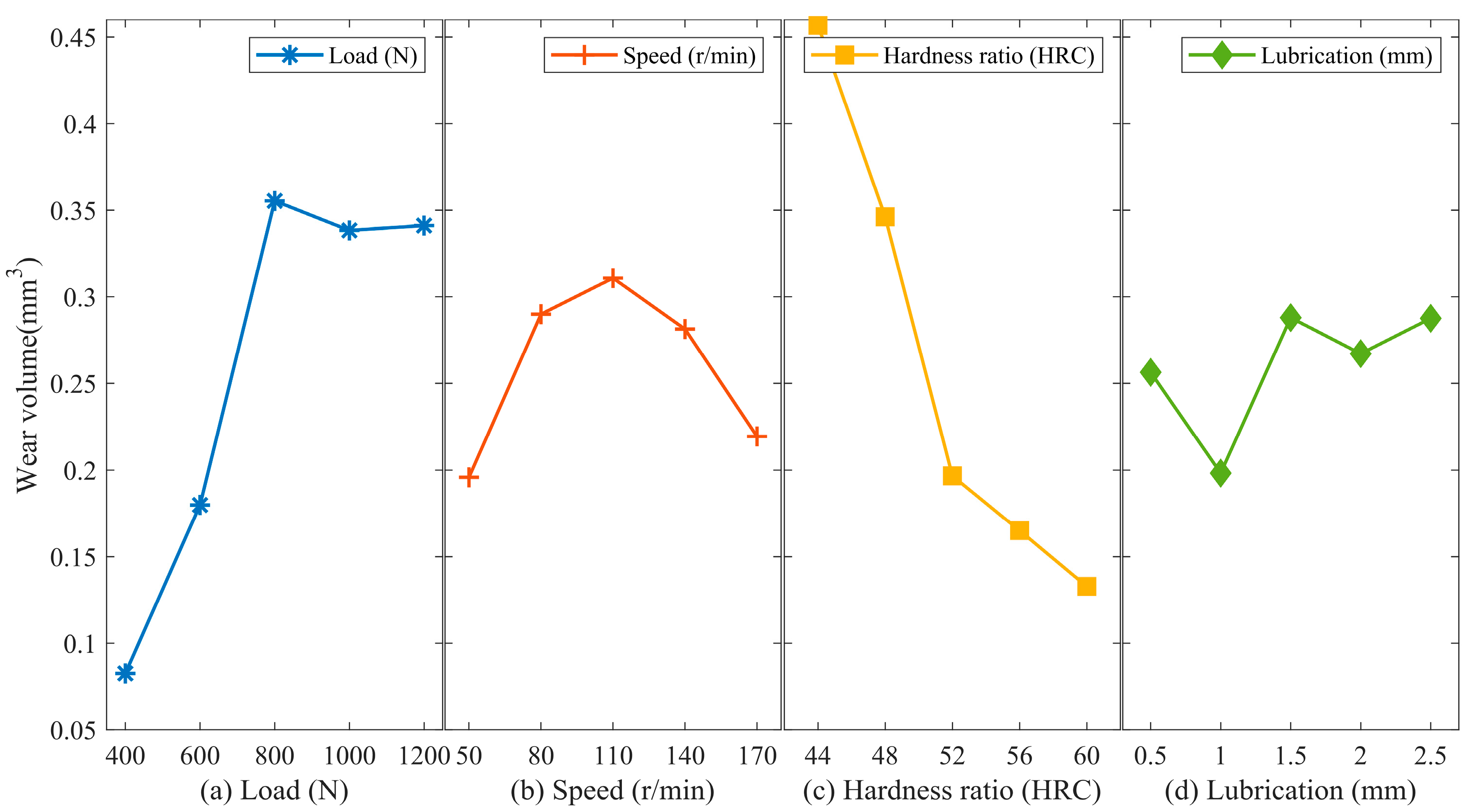
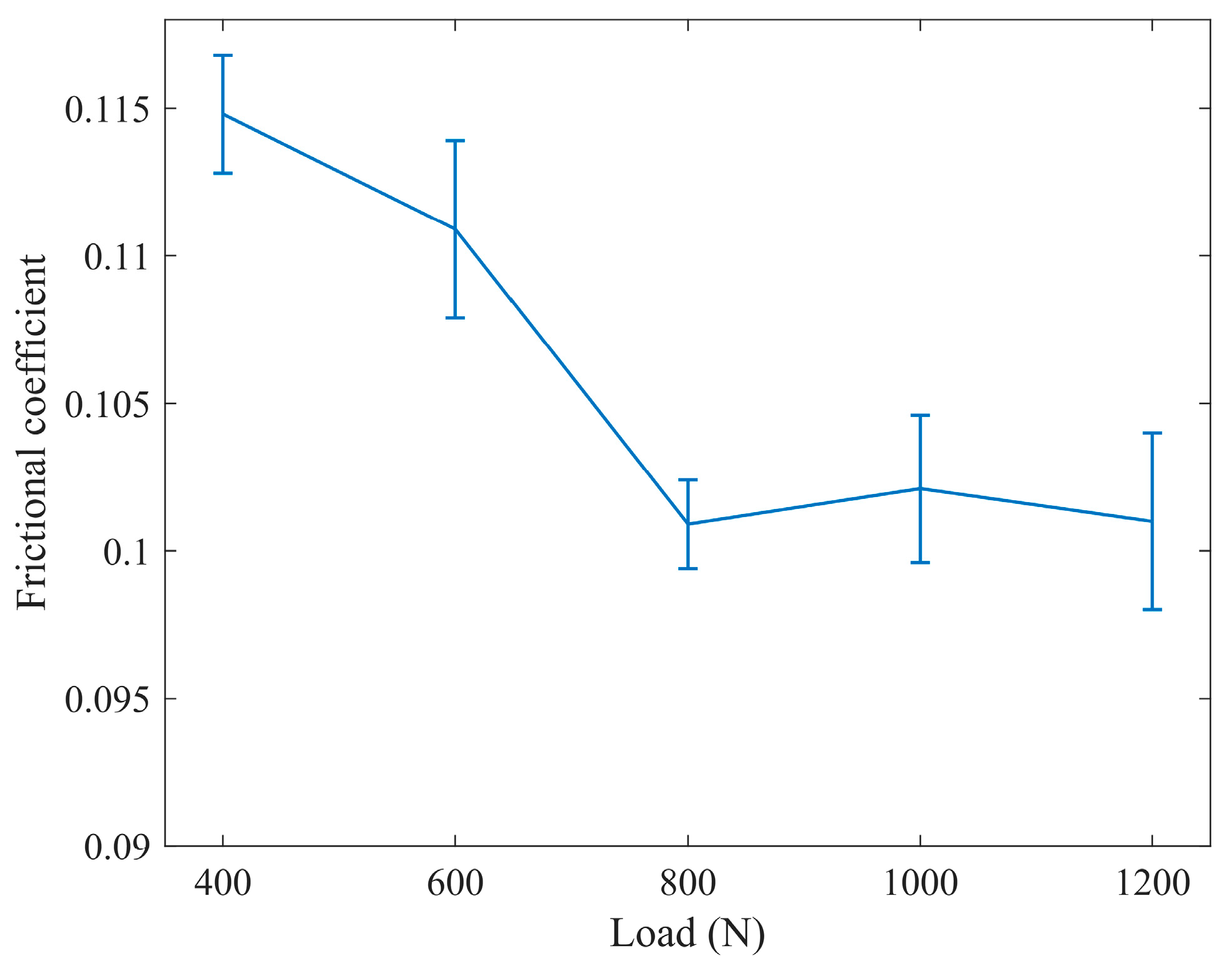
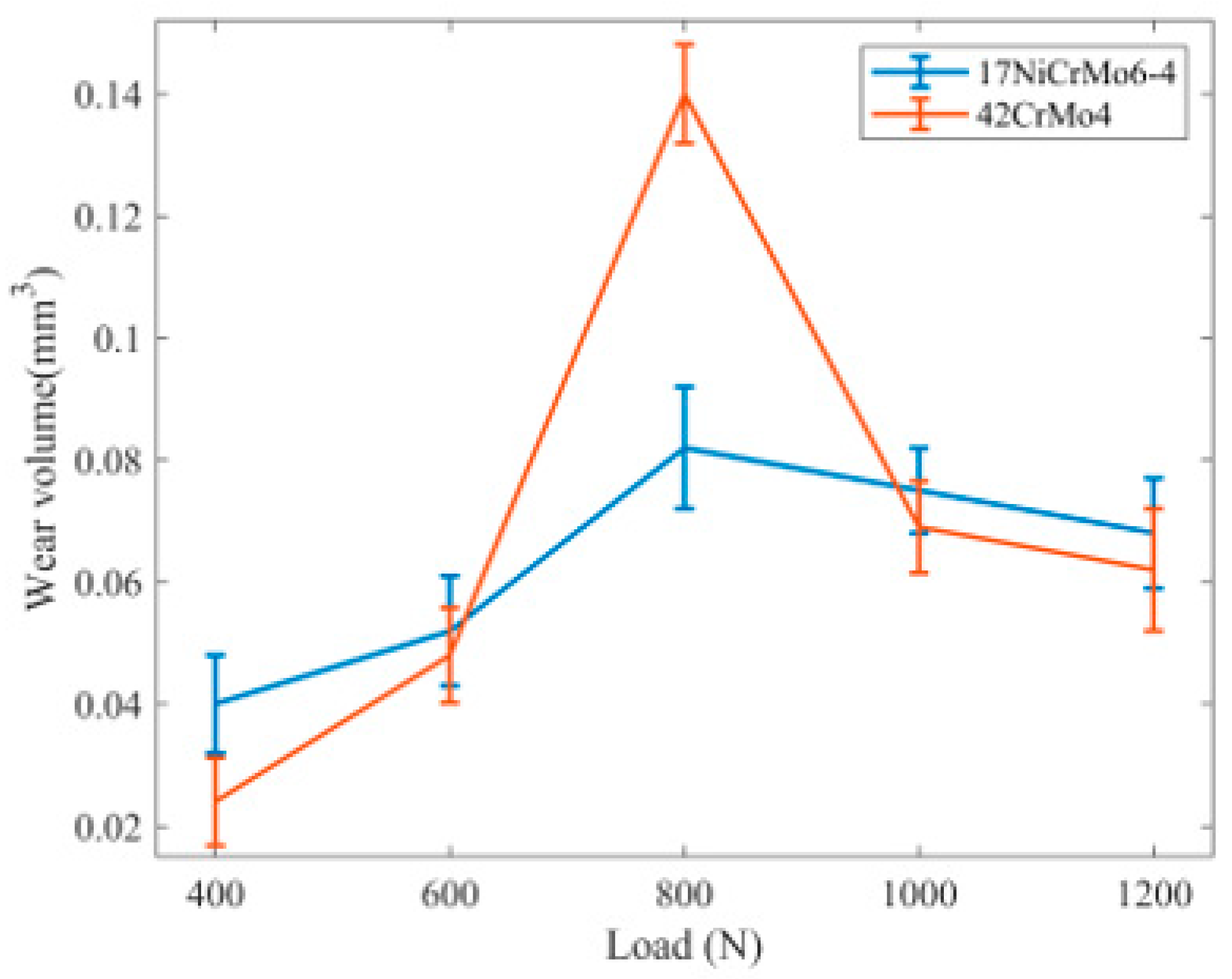
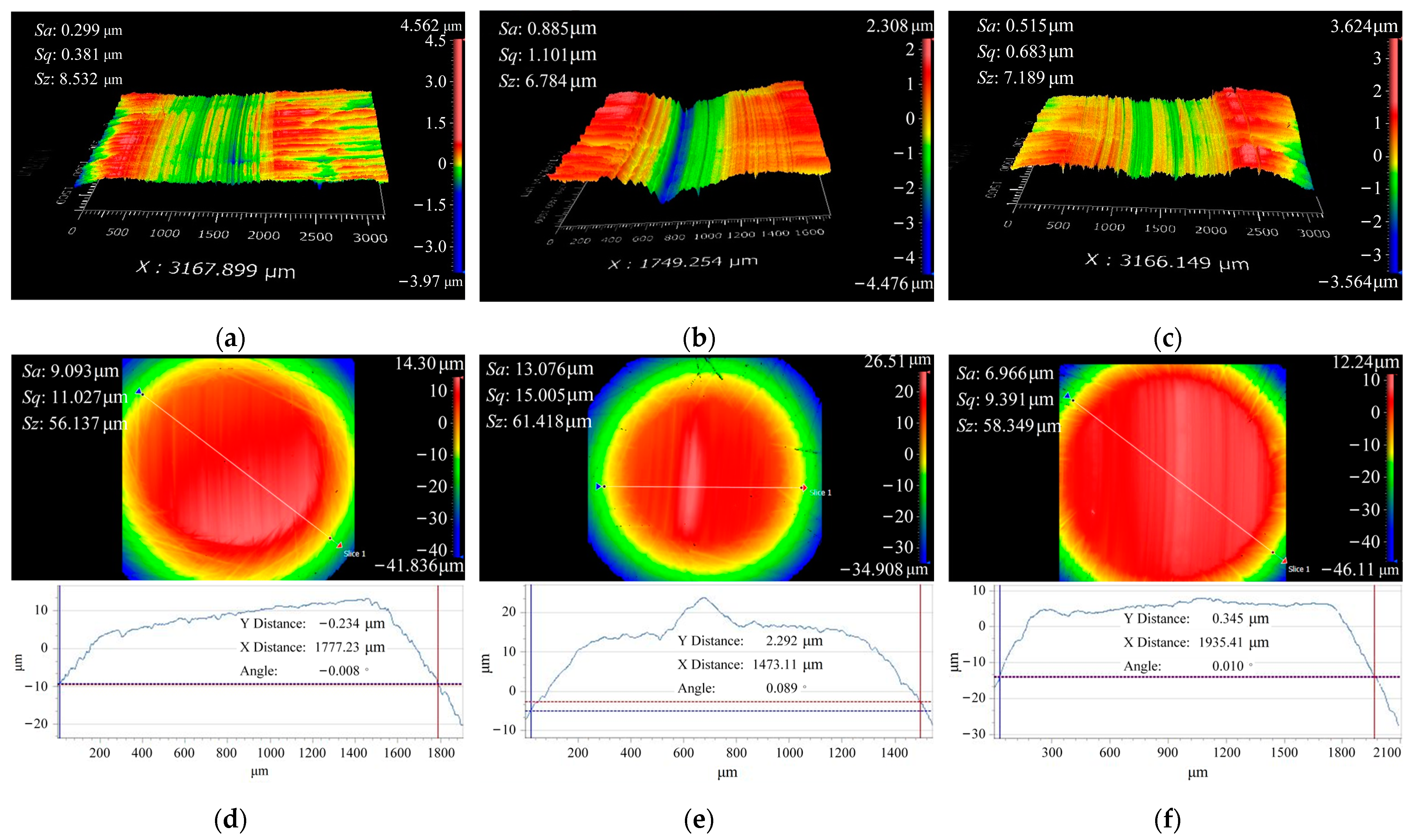
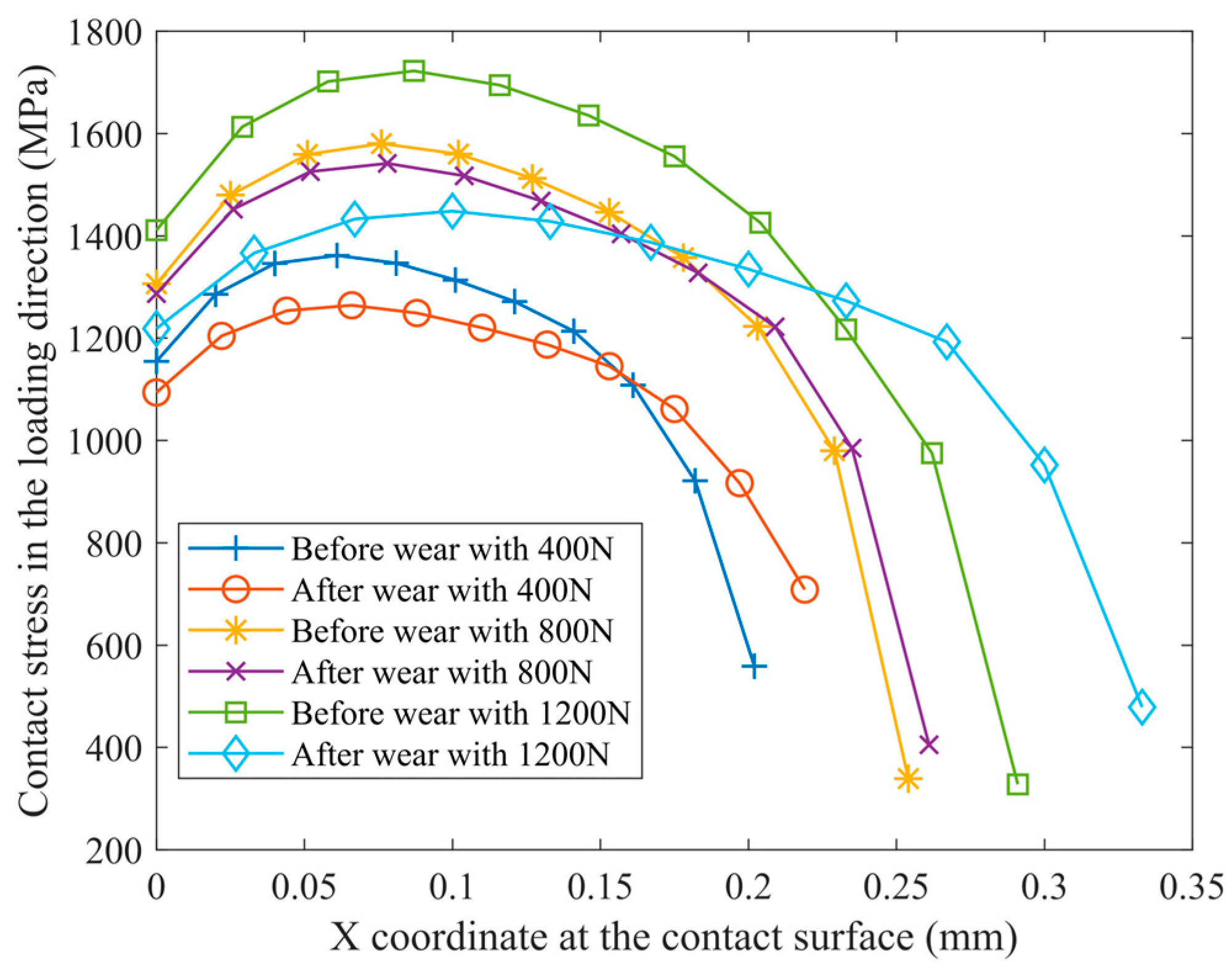

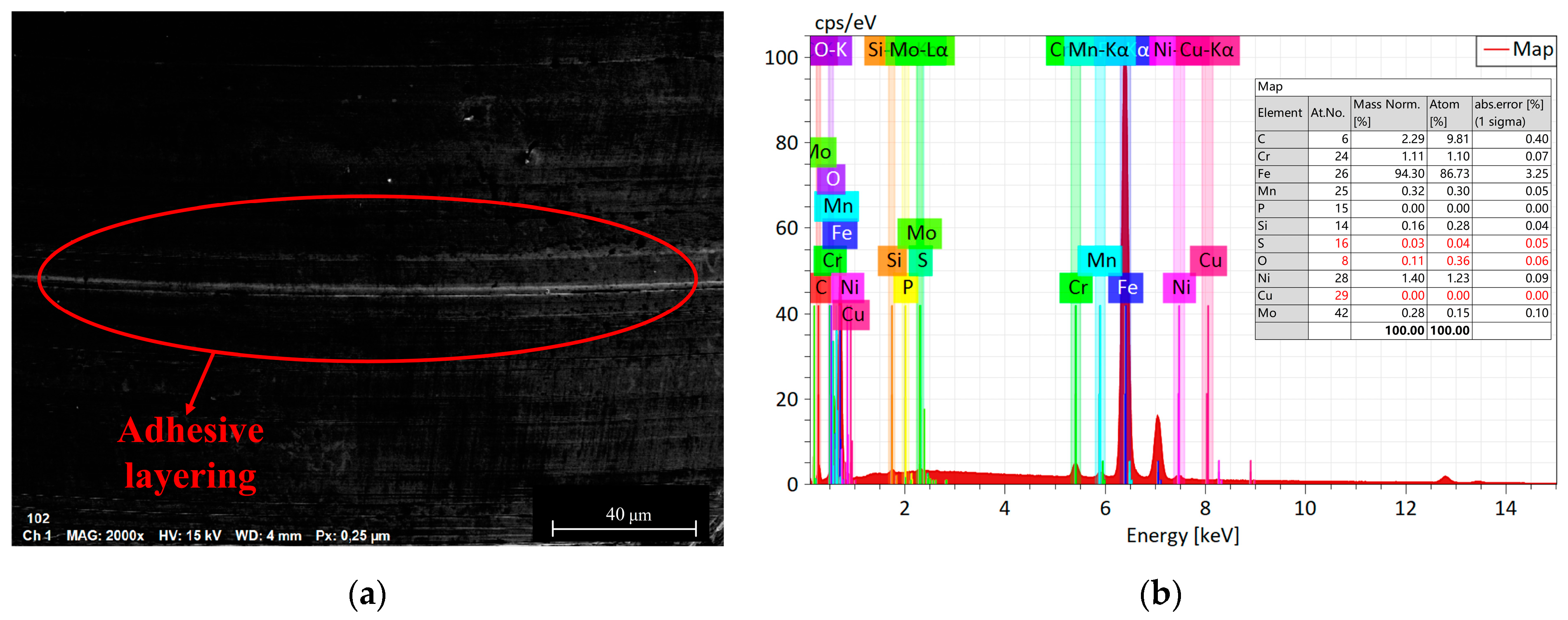
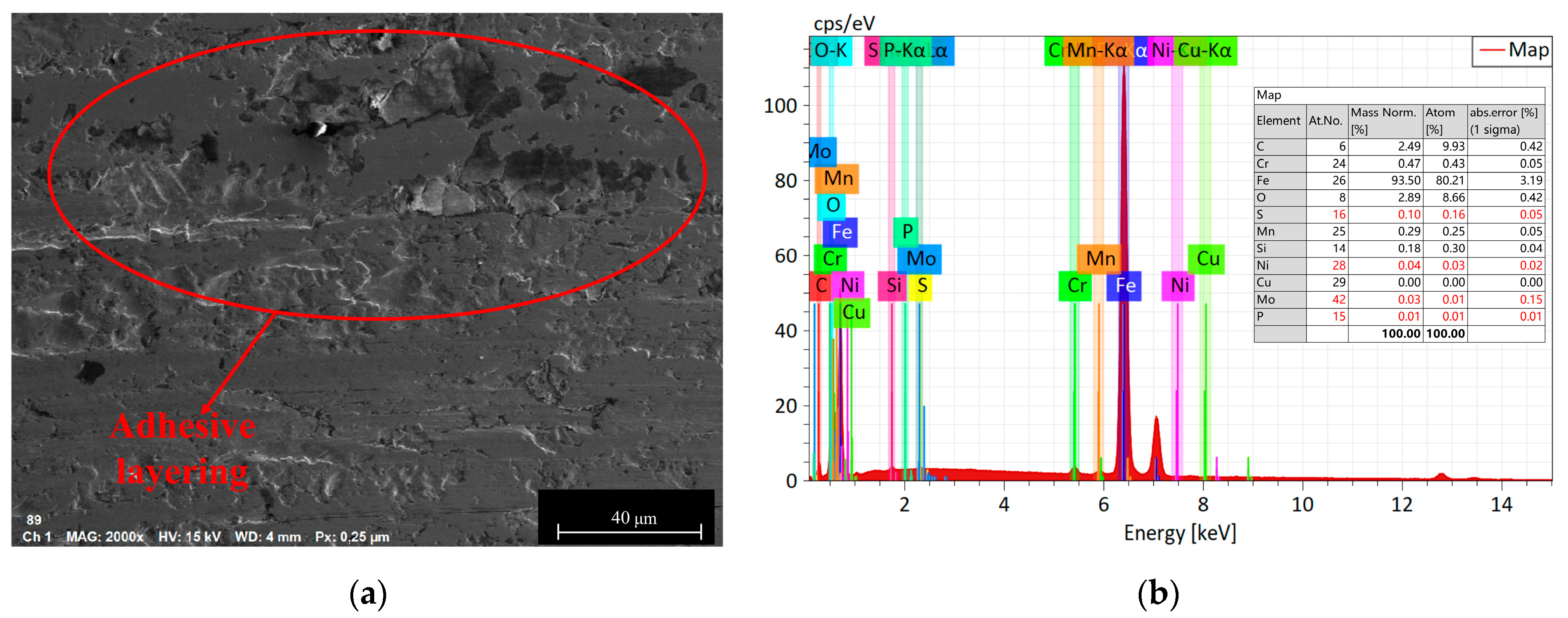
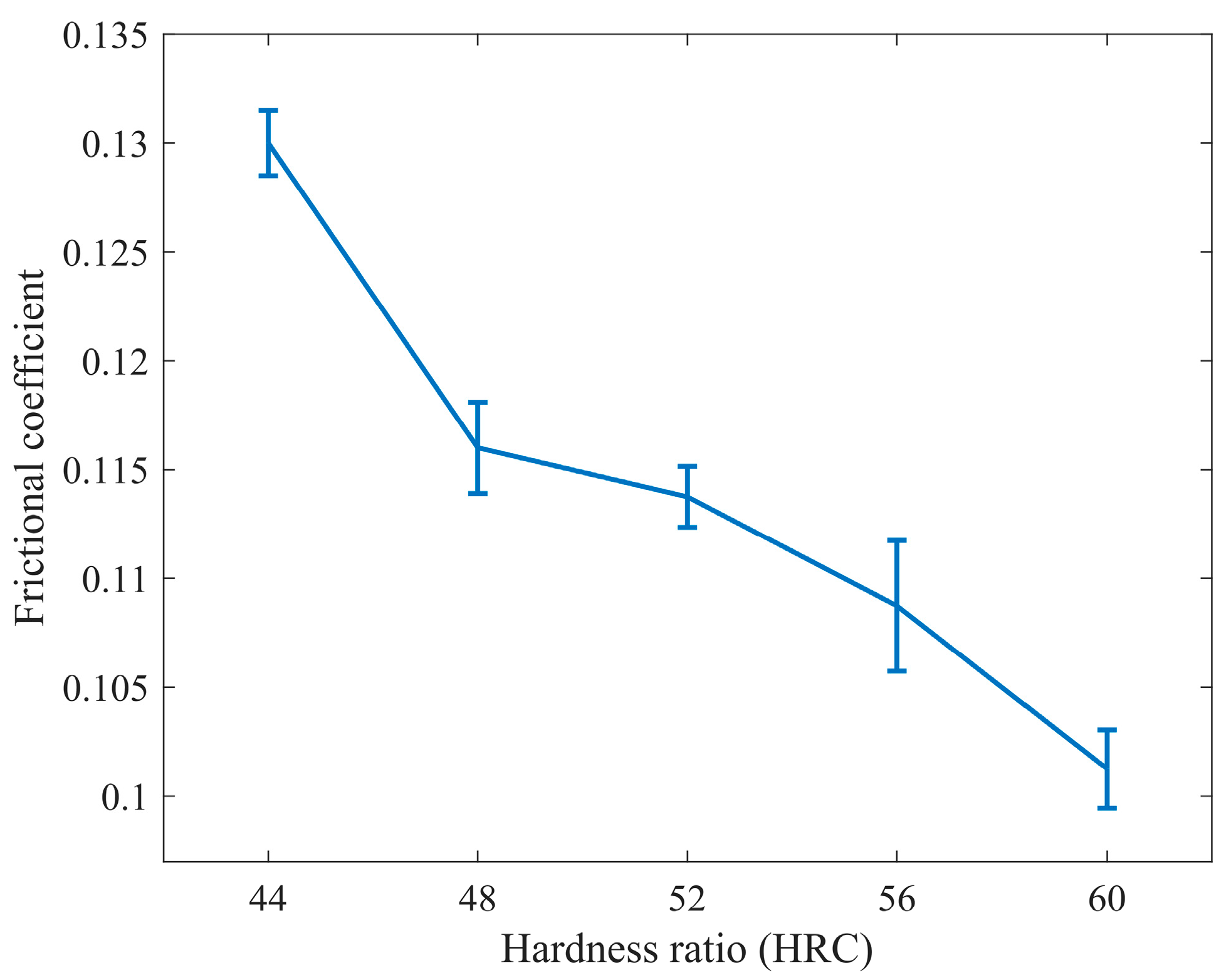
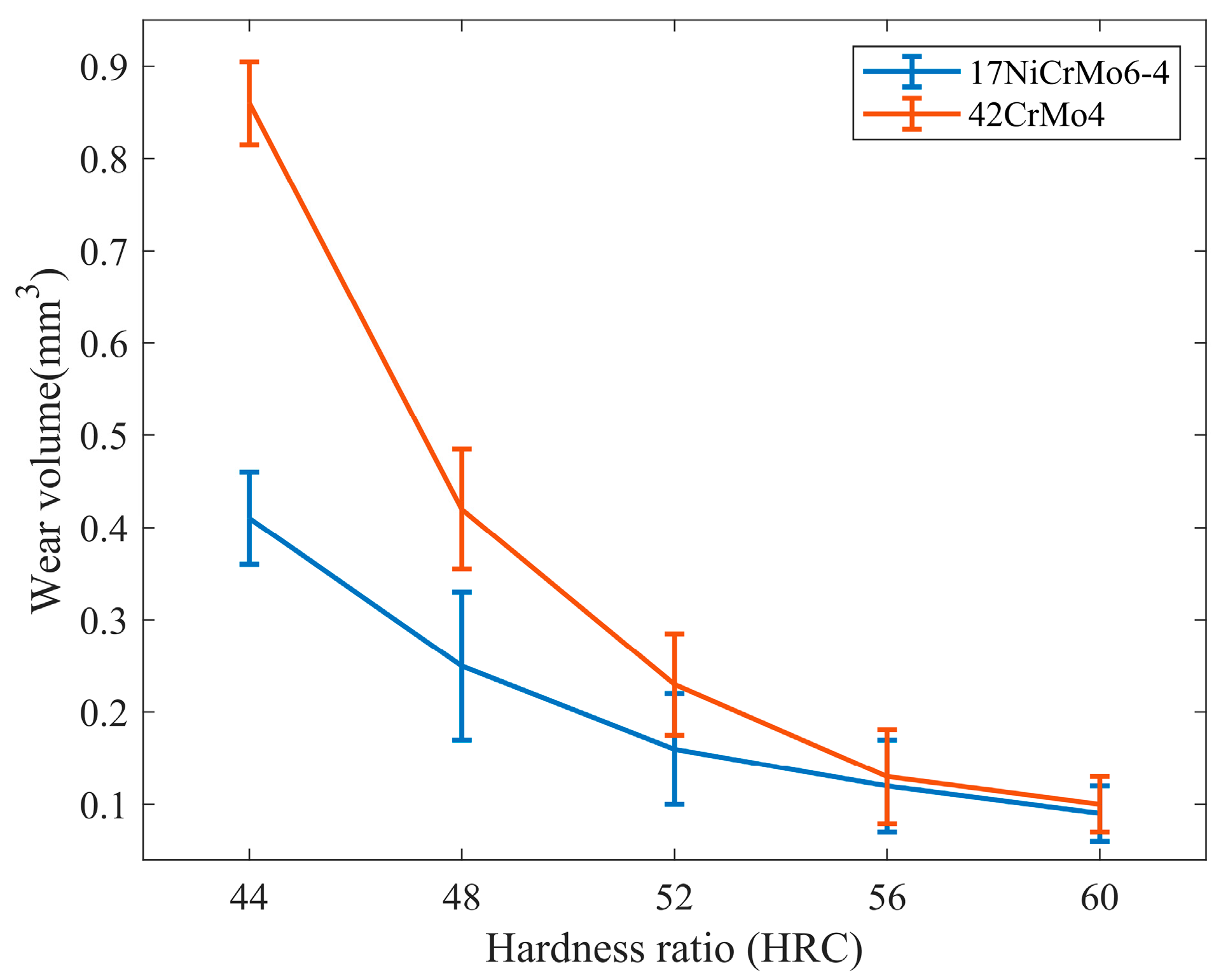
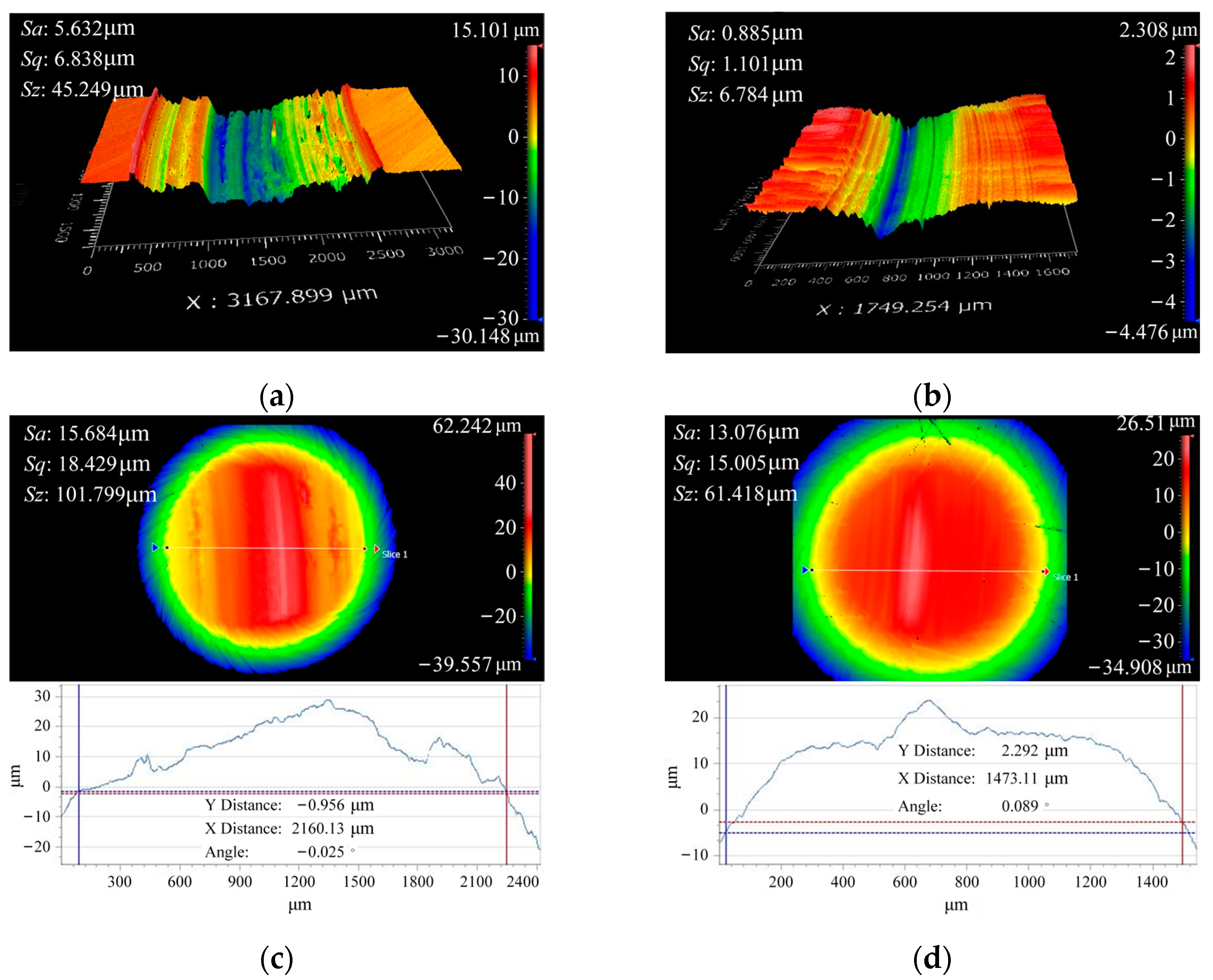


| Element | Fe | Ni | Cr | Mo | C | Si | Mn |
|---|---|---|---|---|---|---|---|
| content% | rest | 1.6 | 1.5 | 0.30 | 0.18 | <0.40 | 0.50 |
| Element | Fe | Cr | Mo | C | Mn | Si | Cu |
|---|---|---|---|---|---|---|---|
| content% | rest | 1.2 | 0.25 | 0.40 | 0.80 | 0.30 | 0.35 |
| Production Data | AG14-61 |
|---|---|
| Chemical composition, thickener | aluminum complex soap |
| Chemical composition, type of oil | synthetic hydrocarbon oil |
| Solid lubricants, percentage | approx. 20% by weight |
| Lower service temperature | −50 °C/−58 ℉ |
| Upper service temperature | 120 °C/248 ℉ |
| Color space | white |
| Texture | homogeneous |
| Worked penetration, DIN ISO 2137, 25 °C, lower limit value | 360 0.1 |
| Worked penetration, DIN ISO 2137, 25 °C, upper limit value | 360 0.1 |
| Kinematic viscosity of the base oil, DIN 51,562 pt. 01/ASTM D-445/ASTM D 7042, 40 °C | approx. 65 |
| FZG scuffing test, based on DIN ISO 14,635, A/2,76/room temperature, scuffing load stage | ≥12 |
| Water resistance, DIN 51,807 pt. 01, 3 /90 °C, rating | 0–90 |
| Drop point, DIN ISO 2176, IP 396 | ≥180 °C |
| Flow pressure of lubricating greases, DIN 51,805, test temperature: −50 °C | ≤1400 |
| Factor | Level | ||||
|---|---|---|---|---|---|
| 1 | 2 | 3 | 4 | 5 | |
| Load/ | 400 | 600 | 800 | 1000 | 1200 |
| Speed/ | 50 | 80 | 110 | 140 | 170 |
| Hardness matching/ | 60–44 | 60–48 | 60–52 | 60–56 | 60–60 |
| Lubrication/ | 0.5 | 1 | 1.5 | 2 | 2.5 |
| Factor | Level | ||||
|---|---|---|---|---|---|
| 1 | 2 | 3 | 4 | 5 | |
| Load/ | 400 | 600 | 800 | 1000 | 1200 |
| Speed/ | 90 | ||||
| Hardness matching/ | 60–60 | ||||
| Lubrication/ | 1.5 | ||||
| Factor | Level | ||||
|---|---|---|---|---|---|
| 1 | 2 | 3 | 4 | 5 | |
| Load/ | 800 | ||||
| Speed/ | 90 | ||||
| Hardness matching/ | 60–44 | 60–48 | 60–52 | 60–56 | 60–60 |
| Lubrication/ | 1.5 | ||||
Disclaimer/Publisher’s Note: The statements, opinions and data contained in all publications are solely those of the individual author(s) and contributor(s) and not of MDPI and/or the editor(s). MDPI and/or the editor(s) disclaim responsibility for any injury to people or property resulting from any ideas, methods, instructions or products referred to in the content. |
© 2023 by the authors. Licensee MDPI, Basel, Switzerland. This article is an open access article distributed under the terms and conditions of the Creative Commons Attribution (CC BY) license (https://creativecommons.org/licenses/by/4.0/).
Share and Cite
Wu, F.; Jiang, Z.; Liu, Z.; Sun, Y.; Li, X. Analysis of Influencing Factors on the Tribological Behavior of 42CrMo4/17NiCrMo6-4 under Grease Lubrication. Materials 2023, 16, 6699. https://doi.org/10.3390/ma16206699
Wu F, Jiang Z, Liu Z, Sun Y, Li X. Analysis of Influencing Factors on the Tribological Behavior of 42CrMo4/17NiCrMo6-4 under Grease Lubrication. Materials. 2023; 16(20):6699. https://doi.org/10.3390/ma16206699
Chicago/Turabian StyleWu, Fenghe, Zhanpeng Jiang, Zijian Liu, Yingbing Sun, and Xiang Li. 2023. "Analysis of Influencing Factors on the Tribological Behavior of 42CrMo4/17NiCrMo6-4 under Grease Lubrication" Materials 16, no. 20: 6699. https://doi.org/10.3390/ma16206699
APA StyleWu, F., Jiang, Z., Liu, Z., Sun, Y., & Li, X. (2023). Analysis of Influencing Factors on the Tribological Behavior of 42CrMo4/17NiCrMo6-4 under Grease Lubrication. Materials, 16(20), 6699. https://doi.org/10.3390/ma16206699






